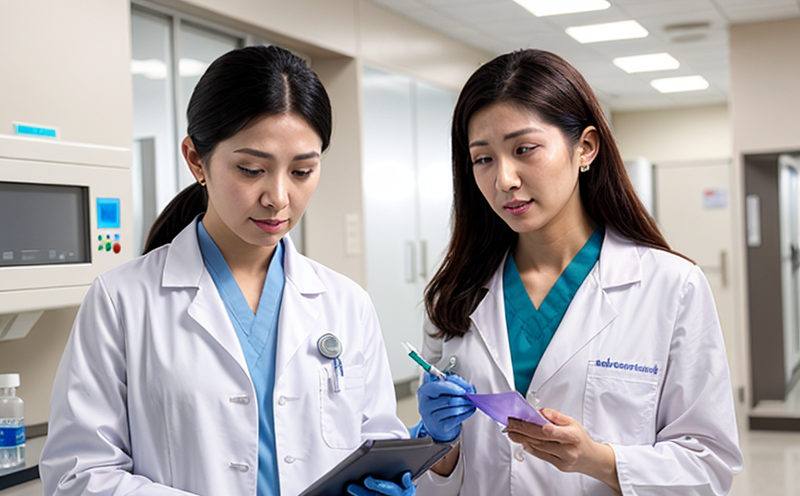USP Assay of Monoclonal Antibodies by ELISA
The United States Pharmacopeia (USP) assay for monoclonal antibodies using Enzyme-Linked Immunosorbent Assay (ELISA) is a critical analytical method in the pharmaceutical sector. This service ensures that biopharmaceutical and biosimilar products meet stringent quality standards, ensuring consistency, purity, and efficacy of these complex biological drugs.
Monoclonal antibodies are large proteins designed to bind specifically to antigens for therapeutic purposes. The USP ELISA assay quantifies the amount of monoclonal antibody present in a sample, which is essential for compliance with regulatory requirements. This service plays a pivotal role in the quality control and assurance processes within biopharmaceutical manufacturing.
The assay involves several steps: sample preparation, coating of the microtiter plate with an antigen, incubation, washing, addition of enzyme-labeled antibody, further washing, and finally, detection using substrate. The final color change is measured spectrophotometrically to determine the concentration of the monoclonal antibody.
This method must adhere to strict USP standards, which ensure that the assay is reproducible, accurate, and precise. Compliance with these standards is crucial for ensuring that the product meets the expectations set by regulatory authorities such as the FDA and EMA.
The reliability of this service lies in its ability to accurately quantify monoclonal antibodies in complex biopharmaceutical formulations. This precision is vital for maintaining consistency across batches, ensuring that each unit of the drug contains the expected amount of active ingredient. The assay also helps in identifying potential batch-to-batch variability and ensuring that the product meets all quality specifications.
The USP ELISA method requires careful attention to detail, including proper sample preparation, optimal conditions for antigen coating, appropriate washing steps, and accurate measurement of final color change. These factors contribute significantly to the accuracy and reliability of the assay results.
Compliance with this standard is not only a regulatory requirement but also an essential part of maintaining patient safety and efficacy. The precision and accuracy of the USP ELISA method ensure that biopharmaceutical products are safe, effective, and consistent across different batches.
| Absorbance | Concentration (ng/mL) |
|---|---|
| 0.5 | 10 ng/mL |
| 1.2 | 20 ng/mL |
| 2.0 | 30 ng/mL |
| 2.8 | 40 ng/mL |
The table above illustrates the relationship between absorbance and concentration, which is a fundamental aspect of this assay.
Applied Standards
| Standard | Description |
|---|---|
| USP ® 1356 | This standard specifies the method for determining the concentration of monoclonal antibodies in biopharmaceuticals. |
| ASTM E2978-16 | This standard provides guidance on the use of ELISA technology in the pharmaceutical industry. |
The USP ® 1356 standard is specifically designed for the quantitative determination of monoclonal antibodies using ELISA. It outlines the procedures, reagents, and conditions necessary to ensure accurate and reliable results. Compliance with this standard ensures that the assay meets regulatory requirements and provides consistent, reproducible results.
The ASTM E2978-16 standard provides additional guidance on the use of ELISA technology in the pharmaceutical industry. It covers a wide range of topics, including method development, validation, and performance characteristics. This standard helps ensure that the assay is robust and can be used reliably across different laboratories.
Industry Applications
| Application | Description |
|---|---|
| Biosimilars Development | The USP ELISA method is crucial in the development of biosimilars. It ensures that the biosimilar product meets the same quality standards as the reference biologic. |
| Quality Control | This service plays a vital role in the quality control processes within biopharmaceutical manufacturing, ensuring consistency and batch-to-batch variability. |
The USP ELISA method is widely used in biosimilars development. It ensures that the biosimilar product meets the same quality standards as its reference biologic. This service helps pharmaceutical companies demonstrate that their biosimilar products are therapeutically equivalent to the reference drug, which is a requirement for regulatory approval.
Quality control is another critical application of this method in the pharmaceutical industry. It ensures that each batch of the product meets all quality specifications. The precision and accuracy of this service help maintain patient safety and efficacy by ensuring that the product is consistent across different batches.
Use Cases and Application Examples
- Biosimilar development for regulatory approval
- Demonstration of therapeutic equivalence between biosimilars and reference biologics
- Quality control to ensure consistency across batches
- Variability assessment in manufacturing processes
The USP ELISA method is commonly used in the development of biosimilars for regulatory approval. By demonstrating that the biosimilar product meets the same quality standards as its reference biologic, pharmaceutical companies can obtain marketing approval from regulatory authorities.
Another use case involves demonstrating therapeutic equivalence between biosimilars and reference biologics. This ensures that patients receiving the biosimilar drug will experience similar efficacy and safety profiles to those receiving the original product.
The method is also used in quality control processes to ensure consistency across batches. This helps maintain patient safety and efficacy by ensuring that each batch of the product meets all quality specifications.
Finally, variability assessment in manufacturing processes can be performed using this service. By identifying potential variations in production, pharmaceutical companies can take corrective actions to maintain consistent quality standards.





